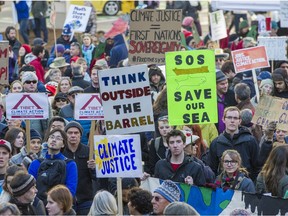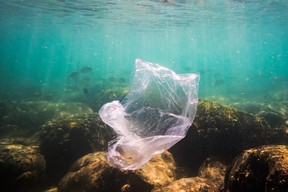Here’s your weekly roundup of local and international climate change news for the week of April 1 to April 7, 2024.

Article content
Here’s all the latest news concerning the climate crisis, biodiversity loss, and the steps leaders are taking to address these issues.
In climate news this week:
Article content
• The paving of Metro Vancouver: More tree planting urged as green spaces shrinking, says report
• Study says Ocean floor a ‘reservoir’ of plastic pollution
• Canadian wildfires drove surge in global tree loss in 2023
Advertisement 2
Article content
Human activities like burning fossil fuels are the main driver of climate change, according to the UN’s Intergovernmental Panel on Climate Change. This causes heat-trapping greenhouse gas levels in Earth’s atmosphere, increasing the planet’s surface temperature. The panel, which is made up of scientists from around the world, has warned for decades that wildfires and severe weather, such as B.C.’s deadly heat dome and catastrophic flooding in 2021, would become more frequent and more intense because of the climate emergency. It has issued a “code red” for humanity and warns the window to limit warming to 1.5 C above pre-industrial times is closing.
But it’s not too late to avoid the worst-case scenarios.According to NASA climate scientists,if we stopped emitting greenhouse gases today, the rise in global temperatures would begin to flatten within a few years. Temperatures would then plateau but remain well-elevated for many centuries. However, according to the Check back here each Saturday for more climate and environmental news or sign up for our new Climate Connected newsletter HERE. (Source: United Nations IPCC, World Meteorological Organization, UNEP, Nasa, climatedata.ca)
Climate change quick facts:

Advertisement 3
Article content
Latest News
The paving of Metro Vancouver: More tree planting urged as green spaces shrinking, says report
An area nine times the size of Stanley Park has been covered in pavement and other impervious materials across Metro Vancouver’s urban core since 2014, according to a report that notes the push to densify could come at a cost to the region’s green spaces and tree canopy.
While the amount of land covered by pavement and buildings increased by four per cent in Metro Vancouver’s urban containment boundary between 2014 and 2020, the tree canopy decreased by one per cent.
Increased growth, plus new provincial housing legislation that allows greater intensification of urban lots will likely lead to further tree canopy cover losses — and the increase of impervious surfaces, says the Metro Vancouver report, which will be presented to the regional planning committee on Friday.
The report cites the need for progressive tree retention and urban forest expansion strategies to offset losses, while Metro Vancouver faces an uphill battle to increase its tree canopy as more trees are being cut down than planted.
Trees provide a range of benefits, including shading and cooling, carbon storage, stormwater management and homes for wildlife.
—Glenda Luymes

Article content
Advertisement 4
Article content
Ocean floor a ‘reservoir’ of plastic pollution, finds global study
Researchers have taken a deep dive into plastic pollution, and found up to 100 times more of the synthetic material blankets the ocean floor than floats on the surface.
Alice Xia Zhu, a PhD Candidate from the University of Toronto who led an international study, said earlier studies have focused more on the plastic floating on the surface but over the decades tonnes of plastic have drifted down to the bottom, and their research shows the amount is significantly higher than previously thought.
“When it accumulates on the ocean floor, there is a potential threat to sensitive ecosystems,” said Zhu in an interview Friday. It can also interfere with the ocean’s capacity to absorb and sequester carbon dioxide, which could accelerate the climate crisis.
Zhu, along with researchers at CSIRO, Australia’s national science agency, used data from remote operated vehicles and from bottom trawls. From this data they estimated there is between three and 11 million metric tonnes of plastic residing on the ocean floor. That’s up to 100 times more plastic on the bottom of the sea than floating on the surface, she said.
The study was published this week in Deep Sea Research Part 1: Oceanographic Research Papers.
—Tiffany Crawford
Canadian wildfires drove surge in global tree loss in 2023, study says
A global forest study says Canadian wildfires last year were entirely to blame for a worldwide surge in tree losses.
The study released by researchers at the University of Maryland on the Global Forest Watch website says tree cover loss in 2023 reached 283,000 square kilometre globally, a 24 per cent jump driven by Canada’s loss of 86,000 square kilometres last year.
Without taking Canada’s losses into account, global tree loss would have decreased by four per cent in 2023, the report says.
The report says more than 90 per cent of Canada’s tree losses last year were due to fires that razed 77,600 square kilometres of forest, a five-fold increase from 2022.
It says Canada’s total loss of tree cover last year, including non-fire-related losses, more than tripled.
“Like in many areas of the world, extensive drought and increased temperatures driven by climate change were widespread across Canada,” the report says.
—The Canadian Press

Advertisement 5
Article content
Underwater microphones aim to protect orcas from ships in B.C.’s Salish Sea
A new method of whale detection will help protect cetaceans from ship disturbances and collisions in B.C.’s Salish Sea, an ocean conservation group announced Thursday.
Vancouver-based Ocean Wise said automatic detections by hydrophones — underwater microphones — will be used to alert nearby commercial mariners of orcas in the area via the group’s Whale Report Alert System.
Such alerts will help mariners determine when to slow down, re-route, or stop to avoid whale disturbance and injury, Ocean Wise said in a news release Thursday.
The underwater station, operated by JASCO Applied Sciences, was commissioned in 2020 by Transport Canada and the Port of Vancouver to detect and track endangered whales and to measure underwater noise emissions of thousands of commercial vessels. But the hydrophones are new and as of Thursday, Ocean Wise said they had received several alerts.
The station is also within the designated critical habitat of the endangered Southern Resident killer whales. On Wednesday, a study by Raincoast and a team of international scientists found that the risk of extinction for this critically endangered species has accelerated, with a worst-case scenario of the species being wiped out in as little as 40 years.
—Tiffany Crawford
Scientists warn efforts ‘urgently needed’ to save B.C.’s endangered southern resident killer whales
Time is running out for the critically endangered population of southern resident killer whales as they face increased threats to their habitat, warns a new study by B.C. conservation group Raincoast and an international team of scientists.
The study, published this week in Communications Earth and Environment, finds there are warning signs of an accelerating decline for these orcas.
This study updates research from eight years ago, which estimates the population has a 24 per cent chance of extinction within 100 years.
Now the situation is dire, with a worst-case scenario of extinction in 40 years.
Habitat degradation through underwater noise, high concentrations of industrial chemicals, and declining quality and quantity of Chinook salmon (in part because of climate change) still inhibit population recovery, the authors conclude.
—Tiffany Crawford
B.C. Hydro opens the door for proposals to charge up province’s grid
B.C. Hydro opened up its anticipated first call in 15 years for private-power producers Wednesday to supply the province’s grid with enough electricity to power the equivalent of 270,000 homes by 2031 at a cost of up to $3.6 billion.
And there are potentially dozens of suitors lining up in the wings preparing bids with 28 applications for exploratory land-use permits filed with the province by proponents of wind, solar and hydro power developments.
Entities exploring wind power are the most numerous with 21 applications including three from the Quebec-headquartered independent power producer Innergex Renewable Energy Inc., one of the biggest operators among B.C. Hydro’s existing portfolio of 125 IPPs.
The private-power sector felt sidelined by former B.C. Liberal premier Christy Clark’s decision in 2014 to approve Hydro’s Site C dam project, which was confirmed by former NDP premier John Horgan’s government upon election in 2017.
B.C. Hydro’s most recent integrated resource plan, however, estimates that demand to power the province’s Clean B.C. ambitions for electrifying B.C.’s vehicle fleet, home heating and industry will start to outstrip Site C’s supply before the end of the decade, said Energy and Mines Minister Josie Osborne.
—Derrick Penner

Advertisement 6
Article content
Fires from 2023 still smouldering under snow reveal B.C.’s dangerous new reality
As skiers glide down the slopes of Whistler Mountain and ice fishers drop their lines into frozen lakes in Alberta, dozens of the fires whose smoke darkened North America’s skies last year are still burning — with some smouldering beneath layers of snow.
These so-called “zombie fires” are a sign of a grim new normal that’s wreaking havoc even in far northern countries like Canada: A fire season that almost never ends.
B.C. had 90 zombie blazes still burning as of mid-March, holdovers from last year’s record fire season, while Alberta started the year with 64 fires carried over from 2023 — more than 10 times the five-year average. As spring temperatures melt snow and uncover land parched by drought, those fires and new ones are poised to flare up, posing a fresh threat to Canada’s forests, not to mention the world’s atmosphere.
The worst fire season on record in Canada made global headlines last year when smoke from the blazes blotted out the skies above New York and other U.S. cities, spawned a rare pyro-tornado and forced the evacuations of an estimated 232,000 people. The fires burned an area that was more than seven times the historic average — or about 4 per cent of the country’s forests, according to a new study.
—Bloomberg News
B.C. Hydro electricity credit starts
In a month when costs — from the carbon tax and beer and alcohol to B.C. Ferries fares — are going up, here is some good news.
Starting April 1, British Columbians will get a break on their energy bills with the province’s new electricity affordability credit, which was announced in the budget in February, kicking in.
B.C. Hydro said the credit means the average household will get a $100 savings over the year, while the average business will save about $400.
While electricity bills are going up this year with a planned 2.3 per cent increase already approved by the B.C. Utilities Commission, that approximately $2 a month increase will be more than offset by the credit, which is expected to cost the provincial government $370 million.
—Cheryl Chan
Wild bee habitat near cropland could increase farm income by $79 million a year: UBC study
Improving habitat for wild bees can significantly improve crop yields for farmers, especially as they face increased threats from climate change, says a UBC researcher.
Matthew Mitchell, an assistant professor in the UBC faculties of forestry and land and food systems, along with Nature Conservancy Canada, analyzed the link between diminishing numbers of wild pollinators and reduced farm productivity in a recent study published in Environmental Research Letters.
“We’re losing a lot of these species and the domestic honeybees are having issues. … And it’s it’s becoming harder to keep bees and have them pollinate crops as well,” said Mitchell in an interview.
“I think there’s a realization that we need to focus on diverse wild species because it provides kind of insurance with climate change. Some species may decrease … what if we just rely on honeybees and we lose the honeybees. What do we do now? We’re stuck.”
In B.C., researchers looked at areas where there was less that 30 per cent natural habitat within two kilometres of cropland that needs pollinators. They then predicted crop yields if that habitat was more than 30 per cent, and calculated that with improved pollinator numbers farm income would increase by $79 million a year.
He said the tricky part is finding land to restore for wild habitat when farmers need to use it to plants more crops, especially when extreme weather affects harvest.
—Tiffany Crawford
Southeast Asian countries consider ways to boost ‘green financing’ as region chokes on smog
Senior finance and central bank officials from Southeast Asia and major economies met Thursday in the scenic Laotian city of Luang Prabang to discuss ways to help the region build resilience against shocks like the COVID-19 pandemic and natural disasters brought on by climate change.
The need for faster progress was dramatically apparent as the city and surrounding region were engulfed in heavy smoke from fires _ some set to clear forests for crops, some ignited by record high temperatures and tinder-dry conditions. The air quality index early Thursday was nearly 300, or “very unhealthy.”
Laos and other countries in Southeast Asia have committed to seeking more sustainable ways to feed their people and power their economies. The question is where the money will come from to do that.
Green finance is among several items on the agenda of the finance meetings of the Association of Southeast Asian Nations related to countering the mounting impacts of global warming. The officials also were set for talks on an ASEAN infrastructure fund and disaster risk financing and insurance, according to the agenda provided by hosts of this week’s meetings.
Also on the list, refining a “taxonomy” to help identify and agree on projects that support ASEAN’s sustainability agenda and align with its climate change commitments and other goals.
—The Associated Press
Social Media
Advertisement 7
Article content
Advertisement 8
Article content
Guides and Links
B.C. Flood: Read all our coverage on the Fraser Valley and beyond
Frequently asked questions about climate change: NASA
What is climate change? A really simple guide from the BBC
Climate change made B.C. heat wave 150 times more likely, study concludes
B.C.’s heat wave: Intense weather event is linked to climate crisis, say scientists
Expert: climate change expected to bring longer wildfire seasons and more area burned
Bookmark our website and support our journalism:Don’t miss the news you need to know — add VancouverSun.com and TheProvince.com to your bookmarks and sign up for our newsletters here.
You can also support our journalism by becoming a digital subscriber: For just $14 a month, you can get unlimited access to The Vancouver Sun, The Province, National Post and 13 other Canadian news sites. Support us by subscribing today:The Vancouver Sun|The Province.
Article content



